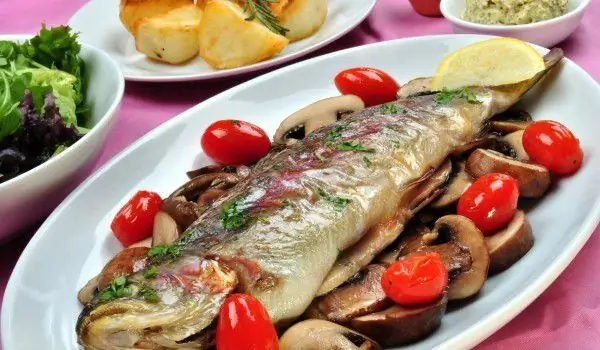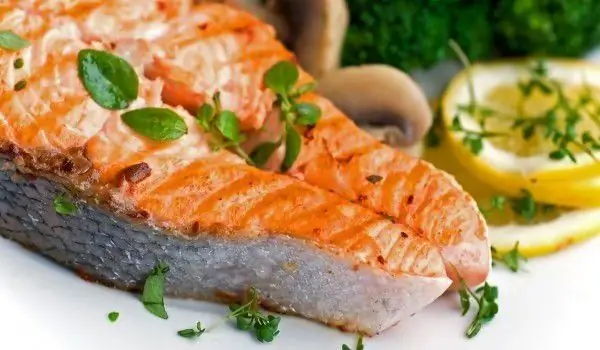2025 Author: Jasmine Walkman | [email protected]. Last modified: 2025-01-23 10:18
The trout is a collective colloquial term for several species of cold-water fish from the Trout family. The trout family includes several species - Balkan trout, rainbow trout, gray trout, hybrids between them, and there are also Ohrid trout and salmon trout.
Most often, trout inhabit the upper reaches of rivers, alpine lakes and dams, where the water flows quite strongly and quickly and is rich in oxygen. As soon as the trout reaches the middle course of such water channels, it returns to the upper reaches because the middle one is warmer. Lake trout maneuver between the reservoir they inhabit and the rivers and streams that flow in or out of it.
The trout is extremely demanding in terms of water quality and temperature. This fish does not tolerate oxygen concentrations lower than 7 -12 ml per liter of water, as well as temperatures above 5 -10 degrees. Usually trout can be found at an altitude of 2000 m, and in the valleys, and at the appropriate temperature and oxygen concentration can be found in the rivers in the plains.
Fish from the Trout family usually spawn in the winter, and in the spring the young hatch. The female trout chooses a suitable place to spawn and digs the pebbles at the bottom with its tail. In this way she makes small pits where she spawns. At the same time, the male sheds semen, as a result of which the fertilized caviar becomes heavier than water and remains at the bottom.

The trout grows quite fast. Its weight reaches enviable sizes, reaching 35 kg in the best cases. However, this does not apply to river trout, which weigh no more than 800 grams. All species of the trout family are of great economic importance. Probably the most important in fish farming is the rainbow trout, which is one of the most common objects of sport fishing for each other with cold-water fish.
Trout is also grown in fish farms with the amount of dissolved oxygen in the water over 7 mg / l and a temperature of 12-20 degrees. Such farms are called cold-water. The members of the Trout family are distributed in the free state in North America, Europe and Asia. In the process of evolution, many species and subspecies of trout are derived from them.
Species of trout
Rainbow trout - Widespread in the North in two varieties - true arcuate and steel-headed. The body length of the true rainbow trout is between 25 to 65 cm, weighing between 2 and 7 kg, and the steel head - between 50 to 100 cm and weighing up to 10 kg. The true rainbow trout, which is tastier of both species, is thought to have greater culinary value, although the steelhead has richer protein and fatter meat;
Ohrid trout (Salmo letnica) - is an endemic species for the region only on Lake Ohrid. Later it was acclimatized in Lake Vlasina, Serbia, in some reservoirs in the United States and others. places. It is considered an extremely expensive delicacy. This unique for the region of Macedonia representative of the Trout family reaches sizes between 20 and 60 cm in length and weight up to 15 kg;
Brown trout/ Balkan river trout - this is the most common trout in Europe, known by both names. The length of this Balkan trout (Salmo trutta fario) reaches about 40 cm, and its weight varies on average about 10 kg and reaches a maximum of 20 kg. On the sides the body is light brown, and on the abdomen almost yellow, like large pink spots on both sides;

Dark brook trout - This is a smaller and more typical for Europe trout, but it is also bred in the cold mountainous regions of North America. It is considered a delicacy fish, which has a length of only 20-25 cm and a modest weight - about 1-2 kg. Characteristic of the dark brook trout is the dark olive color of the scales.
Silver trout - this is an extinct non-migratory species of trout. It was found in the area of several lakes in Ireland and until 1960 its disappearance was a consequence of the artificial introduction into the lakes of a non-specific species of fast-growing predatory fish;
Salmon trout - This is a large marine species that combines the beneficial qualities of salmon and trout. It is characterized by tender pink to banana-colored flesh, and a mixed taste reminiscent of both types of fish. Sea trout are similar in size to salmon, but differ from it in their wider body. There is also a less pronounced depression of the caudal fin.
Composition of trout
Trout is a relatively expensive, mostly delicacy fish, which is characterized by high nutritional value and many useful ingredients. Inhabiting fast cold water streams, trout is characterized by a very low fat content which is why it is often called a lean fish. It is extremely useful because its meat is rich in Omega 3 fatty acids and fat-soluble vitamins A and D.
In addition, trout contain large amounts of B vitamins. The meat of trout is usually fresh and rich in protein and low in fat. Many omega-3 fatty acids make it extremely important for a complete diet. In addition, trout caviar is rich in vitamin A. In most species of trout fat reaches 6% and protein - about 18-20%.
Selection and storage of trout
In our mountainous areas you can always eat fresh trout. However, if you go to the market, in addition to fresh fish, you can also find smoked or frozen. In fish shops or in large retail chains you can find whole frozen cleaned trout or just filleted.
You will recognize the fresh trout by the clean look and the fresh smell. If you plan to store the trout, it is best to freeze it in the freezer. It is always preferable to immediately cook the fish you bought and enjoy its incredible taste.

Culinary application of trout
Trout is easy to cook, extremely tasty and very useful fish. It is loved by many culinary professionals and a favorite of gourmets with taste. Trout can be prepared in any way - grilled or in the oven, steamed, fried or baked in foil. Trout can be used to make unique fish skewers to enchant your guests.
When cooking trout, keep in mind the rule that the simpler the method of cooking, the tastier the trout and the more its useful ingredients are preserved. Trout is prepared like other fish, washed, cleaned and seasoned with spices, a little lemon juice and olive oil.
The taste of trout combines very well with spices such as devesil and tarragon, as well as garlic, onions, tomatoes, fresh green spices such as parsley. When serving trout, be sure to garnish it with a fresh slice of lemon. Stewed or fresh vegetables, baked potatoes or mashed potatoes are suitable as a side dish to the trout. Trout goes well with your favorite white wine.
Benefits of trout
The trout is one of the foods that is good to include in our diet regularly. Like salmon, trout is extremely beneficial, mainly because of its high content of Omega-3 fatty acids. They are extremely important for the work of the heart and nervous system. Regular eating of trout will charge us with tone, the brain - with energy, and will also make our hair and skin shine. Omega 3 fatty acids are invaluable for dry skin that needs constant nourishment.
Recommended:
Sea Bream, Sea Bass Or Trout To Choose?

Without a doubt, seafood is delicious and healthy. However, when it comes to choice of fish , we begin to wonder which one to choose. The criteria can be many, but usually the most important is the price of the fish and its size. In this article we will introduce you to the pros and cons of three favorite fish - bream, sea bass and trout, so you can more easily make your choice.
About Salmon Trout In Our Latitudes

Salmon trout is not "just an American species", but a hybrid, the result of many years of creative efforts of a team of Yugoslav geneticists. It is an adapted form of the American trout, breeding in the upper reaches of the White Drin.
Salmon And Trout For Dry Skin

Salmon and trout charge the brain with energy, and hair and skin - with radiance. This is mainly due to the omega-3 fatty acids contained in these fish. They are invaluable for dry facial skin that needs nourishment. Salmon is a fish that leaves a feeling of satiety and at the same time is low in calories.
Trout Dishes

The tender trout, which lives in clean mountain streams, rivers and lakes, is a favorite of many connoisseurs of fine dishes. Grilled, boiled or fried, in foil or in the form of skewers, trout is always a sumptuous dish. It is very useful because it is rich in Omega 3 fatty acids and fat-soluble vitamins A and D, contains a large amount of B vitamins.
Trout Mushroom

Trout mushroom / Polyporus squamosus / is a species of basidiomycete fungus, known in Bulgaria as hawk. In Russia it is known as scaly trout, in France - as Polypore écailleux, and in Germany it is called schuppige porling. The English name of the mushroom is dryad’s saddle.

